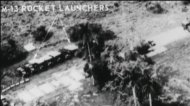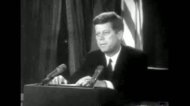50 years after Cuban missile crisis: closer than you thought to World War III
Fifty years after the Cuban missile crisis, many people find it hard to believe that the confrontation could have pushed the US and Soviet Union to nuclear war. Robert F. Kennedy’s newly released papers remind us why this was the most dangerous moment in recorded history.
By Graham Allison | Christian Science Monitor – 12 hrs ago
“My fellow Americans, with a heavy heart, and in necessary fulfillment of my oath of office, I have ordered – and the United States Air Force
has now carried out – military operations with conventional weapons
only, to remove a major nuclear weapons build-up from the soil of Cuba.”
These are the words President Kennedy almost delivered in October
1962 announcing what could have been World War III. This draft speech is
among several thousand drafts, letters, and handwritten notes from Robert F. Kennedy’s personal files that have just last week been opened at the John F. Kennedy Presidential Library.Robert Kennedy’s writings make vivid how close we came to the brink of war. Had President Kennedy been forced to choose a response in the first 48 hours after an American spy plane discovered the Soviets sneaking nuclear-tipped missiles into Cuba, RFK had no doubt that his brother would have chosen an air strike against the missile sites, followed by an invasion. As he wrote in his notes while discussing this option, “if we go in, we go in hard.”
Had the United States launched an airstrike and invaded Cuba, the Soviet commander on the scene would almost certainly have responded with about 100 tactical nuclear weapons under his control – tactical nuclear weapons JFK did not even know were on the island. The US would have felt compelled to respond in kind triggering an escalation to nuclear Armageddon. As RFK later recalled, the Executive Committee of the National Security Council advising JFK during the crisis was full of “bright, able dedicated people, all of whom had the greatest affection for the US, [but] if six of them had been President...the world might have been blown up”.
Instead of the air strike, JFK initially chose to impose a naval blockade on further arms shipments to Cuba. Yet as the Soviets rushed to complete construction of missiles already in Cuba so that they could be fired against American cities, US planning for the air strike was refined.
As Soviet ships approached the blockade line on Oct. 24, 1962, Robert Kennedy wrote that “the danger and concern that we all felt hung like a cloud over us all…I think these few minutes were the time of greatest worry by the President. His hands went up to his face and covered his mouth and he closed his fist…I felt on the edge of a precipice and it was as if there was no way off.”
While the Soviet ships turned around rather than challenge the blockade, the window for US action to prevent the missiles in Cuba from becoming fully operational was rapidly closing. At the State Department on Oct. 26, RFK scribbled down Secretary of Defense Robert McNamara's insistence that after an airstrike against the missile sites, an “invasion must follow!!” The plan called for 500 bombing sorties against Cuba followed by an invasion force of 90,000 American soldiers.
As both sides moved military pieces on the chessboard toward the precipice of nuclear war, both President Kennedy and Soviet Premier Nikita Khrushchev also intensified the search for an alternative. In a private letter from Khrushchev to JFK that arrived on Oct. 26, Khrushchev admonished Kennedy not to “pull on the end of the rope in which you have tied the knot of war, because the more the two of us pull, the tighter that knot will be tied.” RFK’s notes highlighted that phrase.
At the final hour, both leaders made hard choices. They included concessions that neither man would have been willing to countenance until coming face to face with the real prospect that they could be principal actors in a process that would lead to sudden death for hundreds of millions of people. The president chose his brother as the emissary to Soviet Ambassador Anatoly Dobrynin to convey a last and final offer. Khrushchev accepted those terms and the crisis ended without war. In RFK’s notes preparing for his fateful meetings with Ambassador Dobrynin, he stressed that “the purpose to talking...was to emphasize danger.”
What resolved the crisis was an imaginative combination of public deal, private ultimatum, and secret sweetener. If Khrushchev agreed to withdraw the missiles, the US would pledge not to invade Cuba. Privately, RFK warned that unless Khrushchev announced within 24 hours that the missiles would be withdrawn, the US would act unilaterally to eliminate them. Secretly, he said that while there could be no official deal promising such, if the Soviet missiles were withdrawn from Cuba, within six months US missiles in Turkey would be gone.
The further away from those 13 days we get, the harder it is for many people to believe that a confrontation over missiles in Cuba or Turkey could have pushed the United States and the Soviet Union to nuclear war. RFK’s papers allow us to peer over his shoulder in the rush of events to remind us why historians agree that this was indeed the most dangerous moment in recorded history.
Graham Allison is director of Harvard Kennedy School’s Belfer Center for Science and International Affairs and author of “Essence of Decision: Explaining the Cuban Missile Crisis.”
Related stories
- Opinion: For nuclear security beyond Seoul, eradicate land-based 'doomsday' missiles
- Opinion: How Obama can slash defense budget: Cut unnecessary nuclear weapons programs
- Opinion: Three steps to reducing nuclear terrorism
- Opinion: A 'New START' to an arms race between the US and Russia?
- Obama, Hiroshima anniversary, and the future of nuclear weapons
- Russia and the US: Has a season of nuclear disarmament finally arrived?
Become a part of the Monitor community



No comments:
Post a Comment